Europe, British Isles, East England, Norfolk, Salle, Church of St Peter and St Paul [Map]
Church of St Peter and St Paul, Salle is in Salle, Norfolk.
Exterior of Church of St Peter and St Paul, Salle [Map].
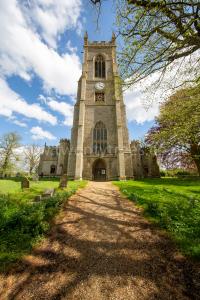
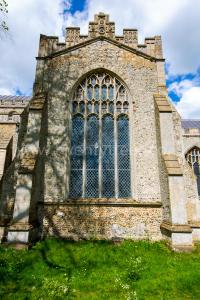
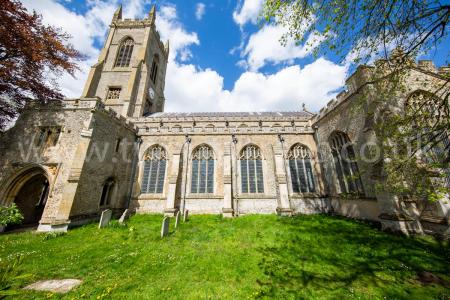
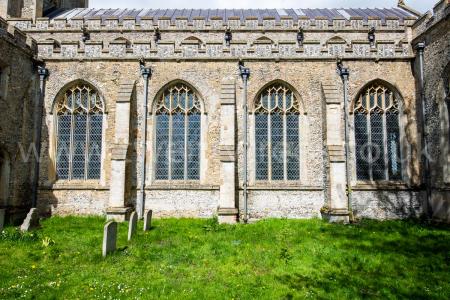
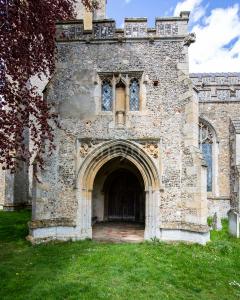
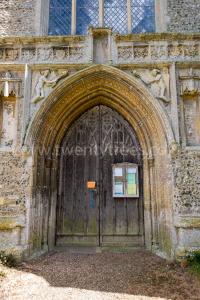
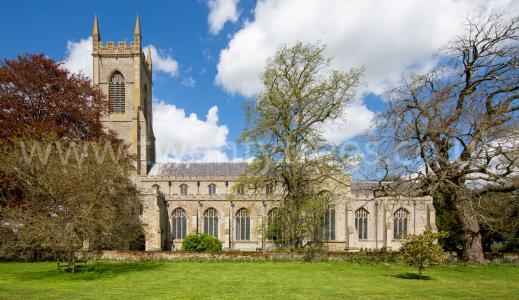
Interior of Church of St Peter and St Paul, Salle [Map].
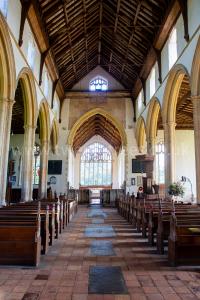
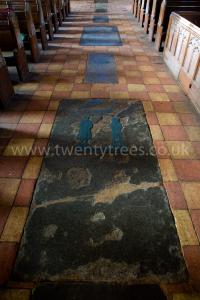
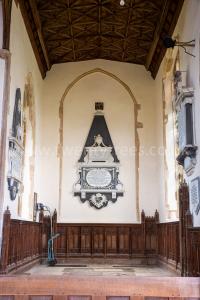
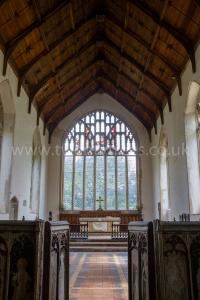
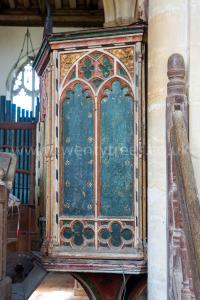
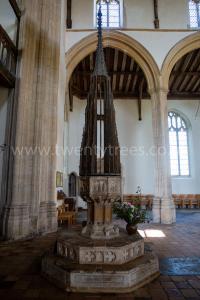
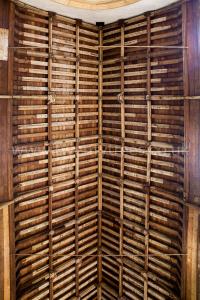
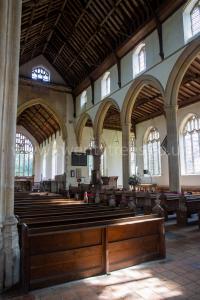
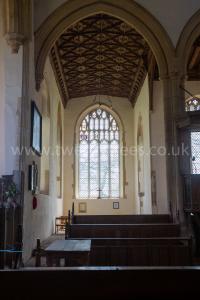
In 1408 Geoffrey Boleyn (age 28) provided timber for the building of Church of St Peter and St Paul, Salle [Map]. The church was paid for by four Lords of the manor, Geoffrey Boleyn (age 28), Thomas Brigge, Thomas Roos and an unknown person, with newly acquired wealth from the wool trade.
On 25 Mar 1440 Geoffrey Boleyn (age 60) died. Around 1414 Alice Bracton (age 29) died. Memorial brass in the floor of the nave of Church of St Peter and St Paul, Salle [Map]. It originally also had tiny figures representing their 5 sons and 4 daughters, but the inlay is lost. Inscription: Hic jacet Galfrid. Boleyn qui obt. 25 die mensis Martij 1440, et Alicie, uxor. ejus, et pueror. suorum, quorum a'i'ab; &c. Label: Dominus propitius esto nobis peccatorib. ie "Here lies Geoffrey Boleyn who died the 25th day of the month of March A.D. 1440, and Alice, his wife, and children, on whose souls may God have mercy Amen"
Geoffrey Boleyn:
Around 1380 he was born to Thomas Boleyn and Anne Jane Bracton.
Before 1406 Geoffrey Boleyn and Alice Bracton were married. They were first cousins. In 1408 Geoffrey Boleyn provided timber for the building of Church of St Peter and St Paul, Salle. The church was paid for by four Lords of the manor, Geoffrey Boleyn, Thomas Brigge, Thomas Roos and an unknown person, with newly acquired wealth from the wool trade.
In 1408 Geoffrey Boleyn provided timber for the building of Church of St Peter and St Paul, Salle. The church was paid for by four Lords of the manor, Geoffrey Boleyn, Thomas Brigge, Thomas Roos and an unknown person, with newly acquired wealth from the wool trade.
Alice Bracton: Around 1385 she was born to John Bracton at Salle, Norfolk.
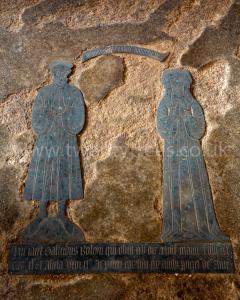
In or after 1481. Memorial brass to John Brigge of Salle (deceased) in Church of St Peter and St Paul, Salle [Map]. He appears as a Cadaver. The inscription reads "Here lyth John Brigge under this marbil ston, Whos sowle our lorde ihu have mercy upon, For in this world worthily he lyved many a day, And here his bodi ys beryed and cowched under clay, So frendis fre whatever ye be pray for me I you pray, As ye me se in soche degree so schall ye be anothir day."
John Brigge of Salle: Before 1454 he was born to John Atte Brigge. In 1481 he died.
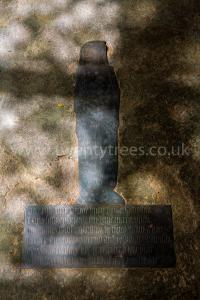
On 03 Aug 1482. Brass to Simon Boleyn (age 35) Vicar of Church of St Peter and St Paul, Salle [Map]. Inscription: Orate p. a'i'a. Simonis Boleyn, capellani, qui obt. 3 die mensis Augi. 1482.
Simon Boleyn: Around 1447 he was born to Geoffrey Boleyn and Ann Hoo. On 03 Aug 1482 Simon Boleyn died.
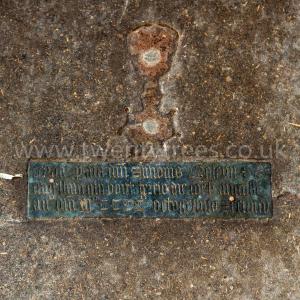
On 04 Apr 1751 John Repps of Mattishall (age 46) died. On 25 Oct 1733 Virtue Boardman (age 38) died. Memorials in Church of St Peter and St Paul, Salle [Map].
John Repps of Mattishall: Around 1705 he was born to John Repps and Dorothy Fountaine. Before 04 Apr 1705 he and Virtue Boardman were married.
Virtue Boardman: In 1695 she was born.
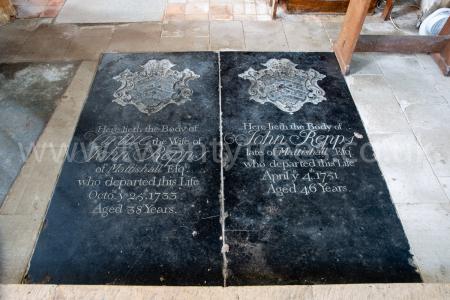
On 09 Apr 1798 Mary Hase died. Memorial in Church of St Peter and St Paul, Salle [Map].
Mary Hase: Thomas Browne Evans and she were married. she was born to Edward Hase of Salle and Virtue Repps.
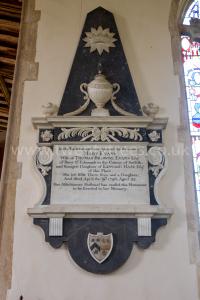
On 11 May 1804 Edward Hase of Salle (age 71) died. On 25 May 1801 Virtue Repps (age 69) died. Memorial in Church of St Peter and St Paul, Salle [Map].
Edward Hase of Salle: Around 1733 he was born to John Hase of Great Melton in Norfolk and Mary Lombe. On 02 Jan 1784 John 1st Lombe Baronet was created 1st Baronet Lombe aka Jodrell of Salle Park in Norfolk with remainder in default of male issue of his own to his brother Edward Hase of Salle and the heirs male of his body and in default thereof to the male issue of Edward Hase's daughter, Virtue Hase. Before 25 May 1801 he and Virtue Repps were married.
Virtue Repps: Around 1732 she was born to John Repps of Mattishall and Virtue Boardman.
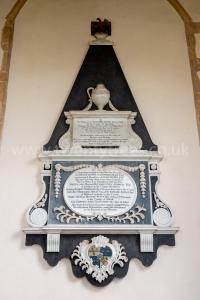
On 12 Nov 1882 Edward Repps Jodrell 3rd Baronet (age 57) died. His first cousin once removed Alfred Jodrell 4th Baronet (age 35) succeeded 4th Baronet Lombe aka Jodrell of Salle Park in Norfolk. In 1890 Amelia Vertue Jodrell died. On her death the estates in Salle, Norfolk were sold. Memorials in Church of St Peter and St Paul, Salle [Map] erected by Alfred Jodrell 4th Baronet (age 35).
Lives of the Queens of England Volume 4 Page 212. In Anne Boleyn's native county, Norfolk, a curious tradition has been handed down from father to son, for upwards of three centuries, which affirms that her remains were secretly removed from the Tower church under cover of darkness, and privately conveyed to Salle church [Map], the ancient burial-place of the Boleyns1,' and there' interred at midnight, with the holy rites that were denied to her by her royal husband at her first unhallowed funeral. A plain black marble slab, without any inscription, is still shown in Salle church as a monumental memorial of this queen, and is generally supposed, by all classes of persons, in that neighborhood, to cover her remains. ‘The mysterious sentence with which Wyatt closes his eloquent memorial of the death of this unfortunate queen affords a singular confirmation of the local tradition of her removal and reinterment:—“God,” says he, “provided for her corpse sacred burial, even in a place as it were consecrate to innocence2.” This expression would lead us to infer that Wyatt was in the secret, if not one of the parties who assisted in the exhumation of Anne Boleyn’s remains, if the romantic tradition we have repeated be indeed based on facts. After all, there is nothing to violate probability in the tale, romantic though it be. King Henry, on the day of his queen’s execution, tarried no longer in the vicinity of his metropolis than till the report of the signal gun, booming faintly through the forest glade, reached his ear, and announced the joyful tidings that he had been made a widower. He then rode off at fiery speed to his bridal orgies at Wolf hall. With him went the confidential myrmidons of his council, caring little, in their haste to offer their homage to the queen of the morrow, whether the mangled form of the queen of yesterday was securely guarded in the dishonored grave into which it had been thrust with indecent haste that noon. There was neither singing nor saying for her, —no chapelle ardente, nor midnight requiem, as for other queens; and, in the absence of these solemnities, it was easy for her father, for Wyatt, or even for his sister, to bribe the porter and sextons of the church to connive at the removal of the royal victim’s remains. That old elm chest could excite no suspicion when carried through the dark narrow streets and the Aldgate portal of the city to the eastern road: it probably passed as a coffer of stores for the country, no one imagining that such a receptacle enclosed the earthly relics of their crowned and anointed queen.
Note 1. The stately tower of Salle church is supposed to be the tallest in Norfolk, and it is certainly one of the most magnificent in the east of England. The profound solitude of the neighbourhood where this majestic fane rises in lonely grandeur, remote from the haunts of village life, must have been favourable for the stolen obsequies of the distinguished queen, if the tradition were founded on fact. Her father was the lord of the soil, and all his Norfolk ancestry were buried in that church. It is situated between Norwich and Reepham, on a gentle eminence.
Note 2. Singer’s edition of Cavendish’s Wolsey, vol. ii. p. 215.